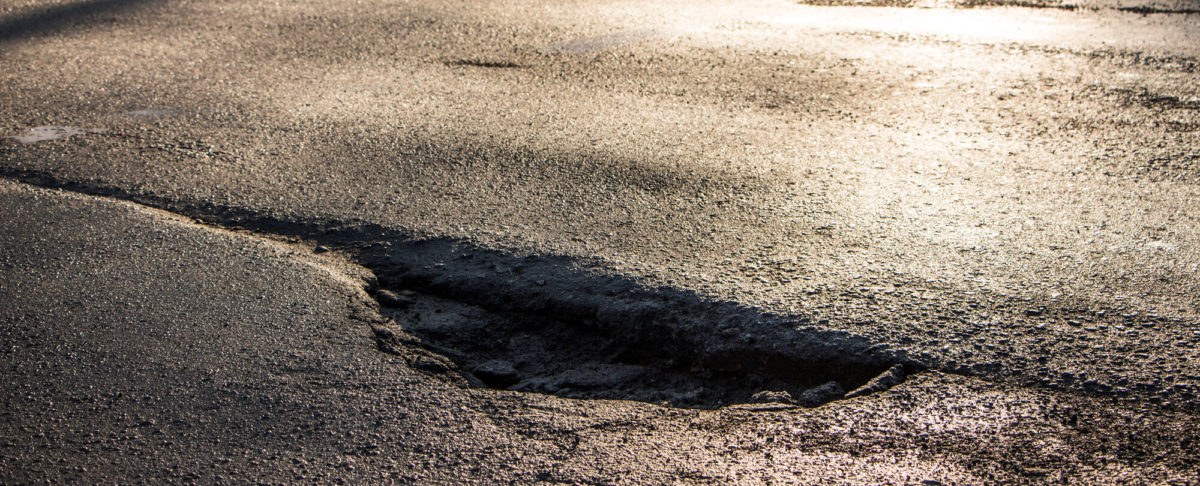Paved commercial parking structures for retail centers, churches, banks, parks, hospitals, universities, restaurants, and many more industries undergo tons – literal tons – of vehicle and foot traffic daily. On top of that constant pressure, other factors like weather conditions can damage the pavement.
Correctly maintaining commercial parking lots is critical for the safety of the people utilizing them. Structural damage like potholes and cracks should be addressed immediately. When the breakdown of a parking lot becomes too expansive, it may result in a total replacement.
What Causes Parking Lot Breakdown?
There are a variety of factors that contribute to the breakdown of commercial pavement. Parking lots are damaged over time by unavoidable natural and humanmade elements, such as:
- Rain
- Snow
- Drastic temperature fluctuations
- High heat levels
- Heavy use
- Heavy vehicle weights
- UV rays
Parking lots inevitably become weathered down over time, so it’s important to recognize the telling signs of parking lot breakdown, in case repair or total replacement is necessary.
Signs Your Parking Lot Needs Repair
Potholes
One of the most obvious, and arguably most irritating signs of parking lot breakdown are potholes. Potholes are unsightly craters in the pavement that diminish your business’s curb appeal and pose a serious safety hazard to pedestrians and vehicles.
Potholes occur when the soil underneath pavement expands and contracts, usually after changes in weather conditions. Since potholes arise after the subsoil has broken down, a complete replacement of the pavement should be considered. Continuously “spot-fixing” potholes after each season can result in further extensive damage down the line.
Cracks
Another surefire sign of structural damage to the pavement in a parking lot is cracking. A variety of factors can cause cracks to form, and when caught early, small cracks can be sealed easily. However, when a crack repair is delayed or ignored, more significant rifts and networks of cracks may form.
There are two different types of cracking that indicate you must replace the pavement. Alligator cracks form when the base of the pavement is compromised, and mimic the look of alligator skin. Small patches of alligator cracks can be spot-fixed with flowing asphalt crack filler. However, if left untreated, extensive alligator cracks allow water to seep in, freeze, expand, and even further damage is inflicted.
Block cracking is common in areas that experience frequent temperature changes. The constant temperature fluctuations result in the appearance of large square or rectangular cracks throughout the surface of the pavement. Block cracking can be avoided with adequate re-coating.
When these networks of cracks form, if actions are not taken to repair them immediately, irreparable damage may occur to the structure. When crack systems become too extensive, complete replacement of the parking lot pavement may be necessary.
Pooling Water
Drainage issues are another result of park lot weathering. Water damage from snow or heavy rain and heavy vehicle use can contribute to the creation of uneven pavement. Pooling water doesn’t necessarily pose a need for complete replacement. However, the drainage should be looked at to ensure proper function. Water should always divert away from the pavement surface.
Common solutions for drainage problems include installing drainage inlets, adding curbs, or adjusting the parking lot’s slope.
Warping or Depressions
Warping or significant depressions in parking lot pavement leads to further drainage issues. Constant vehicular pressure or intense UV rays can result in the expanding and contracting of the pavement. These dips allow water to pool and cause further damage to the parking lot.
Fading Surface
If your parking lot’s surface has gotten to the point of looking faded and weathered, it may be time for a complete replacement. As well as oil or chemical spills, UV rays can degrade the parking lot’s structural integrity, making it dangerous to use.
The routine sealing and maintenance of the pavement can prolong the lifespan of the lot, but ultimately replacement will take place at some point.
Repairing Your Parking Lot
A well built and well-maintained asphalt parking lot can last upwards of 30 years. However, when not taken care of properly, commercial pavement structures can deteriorate in as little as five years. Luckily, there are a few different ways to treat structural problems in parking lots.
If cracks or potholes are noticed and treated early on, flowing asphalt can fill in the damaged areas. When crack systems or large are overlooked, a complete overhaul of the structure may be the only option left, since these are usually signs of significant sub-structure issues.
Infrared asphalt repair is a cost and time-efficient way to replace commercial parking lot pavement. It is also an environmentally conscious choice, as it utilizes recycled asphalt, which is currently the most recycled material in America.
Both residential pavements like driveways and commercial structures like parking lots can have incredibly long lifespans with proper care and maintenance. In places like Minnesota, where temperatures fluctuate significantly, and intense weather conditions are common, consulting a paving professional to help repair your commercial parking lot can improve its lifespan. Recognize the signs of parking lot breakdown before these issues become unmanageable.




